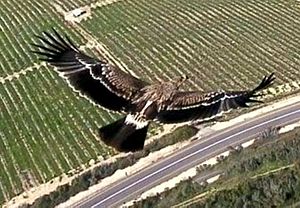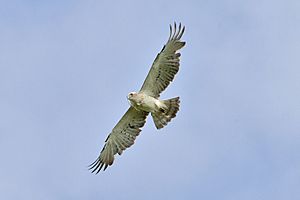Eagle facts for kids
Quick facts for kids Eagle |
|
|---|---|
 |
|
| White-tailed eagle in flight | |
| Scientific classification | |
| Kingdom: | |
| Phylum: | |
| Class: | |
| Order: | |
| Family: | |
Eagles are large birds of prey. This means they are birds that hunt other animals for food. They are related to hawks and some types of vultures. Eagles hunt during the day and have incredibly good eyesight. They can spot their prey from very far away!
The bald eagle is a big eagle from North America. It has a bright white head and tail. This eagle is the national bird of the United States. It usually eats fish. The golden eagle lives in many parts of the world. It often hunts small mammals.
Sometimes, people use the word "eagle" to mean any large hawk. But as a group, eagles are not all closely related to each other. The biggest eagle that ever lived was Haast's eagle. It was the only eagle in the world that was the top predator in its ecosystem. It lived in New Zealand but is now extinct.
Contents
What Makes Eagles Special?
Eagles are large and strong birds of prey. They have big heads and powerful beaks. Even the smallest eagles, like the booted eagle, are strong flyers. They have long, wide wings that help them fly fast and straight. Most eagles are bigger than other hunting birds, except for some vultures.
The smallest eagle is the South Nicobar serpent eagle. It weighs about 450 grams (1 pound) and is about 40 centimeters (16 inches) long. Like all birds of prey, eagles have very large, hooked beaks. They use these beaks to tear meat from their prey. They also have strong, muscular legs and powerful talons. Their beaks are usually heavier than those of most other birds of prey.
Eagles have amazing eyesight. For example, the martial eagle can see up to 3.6 times better than humans! This helps them spot animals from far away. Their eyes have very large pupils. This means less light is scattered, giving them clear vision. In all known eagle species, the female is larger than the male.
Eagle Nests and Chicks
Eagles usually build their nests, called eyries, in tall trees or on high cliffs. Many species lay two eggs. However, the older, bigger chick often kills its younger sibling after it hatches. The dominant chick is usually a female because females are larger than males. The parent eagles do not stop this from happening.
How Eagles Hunt
Because of their size and strength, many eagle species are at the top of the food chain. They are apex predators in the bird world. What they eat depends on the type of eagle.
- The Haliaeetus and Ichthyophaga eagles mostly eat fish. But Haliaeetus eagles also catch other animals, especially water birds. They are also powerful kleptoparasites. This means they steal food from other birds.
- Snake and serpent eagles, like those in the Circaetus and Spilornis groups, mainly hunt the many different snakes found in Africa and Asia.
- Eagles in the Aquila group are often the top hunting birds in open areas. They catch almost any medium-sized vertebrate they can find.
- Many other eagles, like the Spizaetus group, live in forests. These eagles often hunt mammals and birds that live in trees or on the ground. They often surprise their prey in these dense environments.
Eagles have different ways of hunting. Some individual eagles use various techniques depending on where they are and what they are hunting. Most eagles grab their prey without landing. They then fly off with it to a perch to eat it.
The bald eagle has been seen flying with the heaviest load carried by any bird. One bald eagle flew with a 6.8 kg (15 lb) mule deer fawn. Some eagles can even hunt prey much heavier than themselves. This prey is too heavy to fly with. So, the eagle either eats it where it was killed or carries it back in pieces. Golden and crowned eagles have killed animals weighing up to 30 kg (66 lb). A martial eagle even killed a 37 kg (82 lb) duiker, which was 7–8 times heavier than the eagle itself!
Experts on birds have noted a difference in how eagles hunt compared to other birds of prey. Most birds of prey look over their shoulders before attacking prey. This is because hunting can be dangerous for them too. But eagles do not seem to do this.
Biggest Eagles in the World
Eagles include some of the largest birds of prey. Only condors and some Old World vultures are much bigger. People often debate which eagle species is the largest. They can be measured by total length, body weight, or wingspan. Different eagles have different needs based on their lifestyle. For example, many forest eagles, like the huge Harpy eagle, have shorter wingspans. This helps them fly quickly through thick forests. Eagles in the Aquila group, which live in open areas, are excellent soarers. They have long wings for their size.
Here are lists of the top five eagles based on their weight, length, and wingspan:
| Rank | Common name | Scientific name | Body mass |
|---|---|---|---|
| 1 | Steller's sea eagle | Haliaeetus pelagicus | 6.7 kilograms (15 lb) |
| 2 | Philippine eagle | Pithecophaga jefferyi | 6.35 kg (14.0 lb) |
| 3 | Harpy eagle | Harpia harpyja | 5.95 kg (13.1 lb) |
| 4 | White-tailed eagle | Haliaeetus albicilla | 4.8 kg (11 lb) |
| 5 | Martial eagle | Polemaetus bellicosus | 4.6 kg (10 lb) |
| Rank | Common name | Scientific name | Total length |
|---|---|---|---|
| 1 | Philippine eagle | Pithecophaga jefferyi | 100 cm (3 ft 3 in) |
| 2 | Harpy eagle | Harpia harpyja | 98.5 cm (3 ft 3 in) |
| 3 | Wedge-tailed eagle | Aquila audax | 95.5 cm (3 ft 2 in) |
| 4 | Steller's sea eagle | Haliaeetus pelagicus | 95 cm (3 ft 1 in) |
| 5 | Crowned eagle | Stephanoaetus coronatus | 87.5 cm (2 ft 10 in) |
| Rank | Common name | Scientific name | Median wingspan |
|---|---|---|---|
| 1 | Philippine eagle | Pithecophaga jefferyi | 220 cm (7 ft 3 in) |
| 2 | White-tailed eagle | Haliaeetus albicilla | 218.5 cm (7 ft 2 in) |
| 3 | Steller's sea eagle | Haliaeetus pelagicus | 212.5 cm (7 ft 0 in) |
| 4 | Wedge-tailed eagle | Aquila audax | 210 cm (6 ft 11 in) |
| 5 | Golden eagle | Aquila chrysaetos | 207 cm (6 ft 9 in) |
| 6 | Martial eagle | Polemaetus bellicosus | 206.5 cm (6 ft 9 in) |
Where Do Eagles Live?
Eagles live all over the world. Here are some places you can find them:
- Australasia:
- Australia: wedge-tailed eagle, white-bellied sea-eagle, little eagle.
- New Guinea: Papuan eagle, white-bellied sea-eagle, pygmy eagle.
- North America (USA and Canada): golden eagle, bald eagle.
- Central and South America: Spizaetus (four types), solitary eagles (two types), harpy eagle, crested eagle, black-chested buzzard-eagle.
- Europe and Asia: Golden eagle, White-tailed eagle.
Types of Eagles
Eagles are often grouped into four main types. Scientists have studied their family trees. They have found that some eagles that look similar are not always closely related.
Fish Eagles
Fish eagles, also called sea eagles, eat a lot of fish. They catch fresh fish or eat dead fish. Some examples are the Haliaeetus and Ichthyophaga genera.
Booted Eagles
Booted eagles are also called "true eagles." They have feathers on their lower legs, which are called tarsi. Examples include eagles from the Aquila and Hieraaetus groups.
Snake Eagles
Snake or serpent eagles are, as their name suggests, very good at hunting reptiles like snakes. Examples include eagles from the Circaetus and Spilornis groups.
Harpy Eagles
Harpy eagles are very large eagles that live in tropical forests. This group includes a few different species. Even though they live in similar places and hunt in similar ways, they are not all closely related. Examples include the harpy eagle from Central and South America and the Philippine eagle.
Eagle Species List

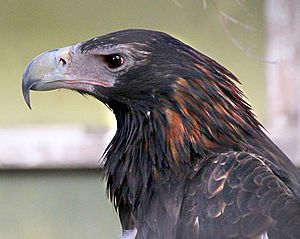
Scientists are always learning more about eagle taxonomy (how living things are classified). New research suggests that some eagle groups, like Aquila and Hieraaetus, might need to be reclassified. This means some species might move to different groups.
Family Accipitridae
- Subfamily Buteoninae – hawks (buzzards), true eagles and sea eagles
- Genus Geranoaetus
- Black-chested buzzard-eagle, Geranoaetus melanoleucus
- Genus Harpyhaliaetus
- Chaco eagle, Harpyhaliaetus coronatus
- Solitary eagle, H. solitarius
- Genus Morphnus
- Crested eagle, Morphnus guianensis
- Genus Harpia
- Harpy eagle, Harpia harpyja
- Genus Pithecophaga
- Philippine eagle, Pithecophaga jefferyi
- Genus Harpyopsis
- Papuan eagle, Harpyopsis novaeguineae
- Genus Spizaetus
- Black hawk-eagle, S. tyrannus
- Ornate hawk-eagle, S. ornatus
- Black-and-white hawk-eagle, S. melanoleucus
- Black-and-chestnut eagle, S. isidori
- Genus Nisaetus
- Changeable or crested hawk-eagle, N. cirrhatus
- Flores hawk-eagle N. floris
- Sulawesi hawk-eagle, N. lanceolatus
- Mountain hawk-eagle, N. nipalensis
- Legge's hawk-eagle, Nisaetus kelaarti
- Blyth's hawk-eagle, N. alboniger
- Javan hawk-eagle, N. bartelsi
- (Northern) Philippine hawk-eagle, N. philippensis
- Pinsker's hawk-eagle (Southern Philippine hawk-eagle), Nisaetus pinskeri
- Wallace's hawk-eagle, N. nanus
- Changeable or crested hawk-eagle, N. cirrhatus
- Genus Lophaetus
- Long-crested eagle, Lophaetus occipitalis
- Genus Stephanoaetus
- Crowned eagle, Stephanoaetus coronatus
- Malagasy crowned eagle, Stephanoaetus mahery (extinct)
- Genus Polemaetus
- Martial eagle, Polemaetus bellicosus
- Genus Hieraaetus
- Ayres's hawk-eagle, H. ayresii
- Little eagle, H. morphnoides
- Pygmy eagle, H. weiskei
- Booted eagle, H. pennatus
- Genus Harpagornis (extinct)
- Haast's eagle, †Harpagornis moorei
- Genus Lophotriorchis
- Rufous-bellied eagle, L. kienerii
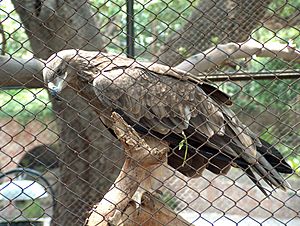 A steppe eagle in Lahore Zoo, Pakistan
A steppe eagle in Lahore Zoo, Pakistan
- Rufous-bellied eagle, L. kienerii
- Genus Aquila
- Bonelli's eagle, Aquila fasciata
- African hawk-eagle, A. spilogaster
- Cassin's hawk-eagle, A. africana
- Golden eagle, A. chrysaetos
- Eastern imperial eagle, A. heliaca
- Spanish imperial eagle A. adalberti
- Steppe eagle, A. nipalensis
- Tawny eagle, A. rapax
- Greater spotted eagle, A. clanga
- Lesser spotted eagle, A. pomarina
- Indian spotted eagle, A. hastata
- Verreaux's eagle, A. verreauxii
- Gurney's eagle, A. gurneyi
- Wahlberg's eagle, A. wahlbergi
- Wedge-tailed eagle, A. audax
- Genus Ictinaetus
- Black eagle, Ictinaetus malayensis
- Genus Haliaeetus
- White-tailed eagle, Haliaeetus albicilla
- Bald eagle, H. leucocephalus
- Steller's sea eagle, H. pelagicus
- African fish eagle, H. vocifer
- White-bellied sea eagle, H. leucogaster
- Sanford's sea eagle, H. sanfordi
- Madagascar fish eagle, H. vociferoides
- Pallas' sea eagle, H. leucoryphus
- Genus Ichthyophaga
- Lesser fish eagle, Ichthyophaga humilis
- Grey-headed fish eagle, I. ichthyaetus
- Genus Geranoaetus
- Subfamily Circaetinae: snake-eagles
- Genus Terathopius
- Bateleur, Terathopius ecaudatus
- Genus Circaetus
- Short-toed snake eagle, Circaetus gallicus
- Black-chested snake eagle, C. pectoralis
- Brown snake eagle, C. cinereus
- Fasciated snake eagle, C. fasciolatus
- Western banded snake eagle, C. cinerascens
- Genus Dryotriorchis
- Congo serpent eagle, D. spectabilis
- Genus Spilornis
- Crested serpent eagle, Spilornis cheela
- Central Nicobar serpent eagle, S. minimus
- Great Nicobar serpent eagle, S. klossi
- Mountain serpent eagle, S. kinabaluensis
- Sulawesi serpent eagle, S. rufipectus
- Philippine serpent eagle, S. holospilus
- Andaman serpent eagle, S. elgini
- Crested serpent eagle, Spilornis cheela
- Genus Eutriorchis
- Madagascar serpent eagle, Eutriorchis astur
- Genus Terathopius
Eagles in Culture and History
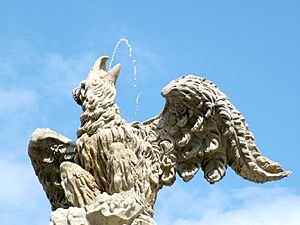
Eagles have been important symbols in many cultures around the world.
What's in a Name?
The English word "eagle" comes from the Latin word Latin: aquila. This might be linked to the Latin word for "dark-colored" because of the eagle's feathers. It could also come from the word for "north wind." In Old English, the word for eagle was [earn] Error: {{Lang-xx}}: text has italic markup (help). This is similar to words for "bird" or "eagle" in other languages, like Greek, Russian, and Welsh. Before 1678 in Britain, "eagle" usually meant the golden eagle. The other native species, the white-tailed eagle, was called an "erne." The name "golden eagle" was made popular by a naturalist named John Ray.
Eagles in Stories and Beliefs

The Moche people of ancient Peru respected the eagle. They often showed eagles in their art. Ancient writers believed that eagles could look directly at the sun. They even said that eagles made their young look at the sun too. Any young eagle that blinked would be pushed out of the nest. People believed this story for a long time.
The eagle is a special animal for the ancient Greek god Zeus. Stories say that Zeus sometimes turned into an eagle. He did this to carry away Ganymede. Many artworks show eagle-Zeus carrying Ganymede. In the Bible, Psalm 103 talks about being made young again "as the eagle." The Bible also mentions that eagles are not clean to eat in Leviticus 11:13. In the Anglican Christian tradition, the eagle is often used to hold the Bible. This symbolizes spreading the gospel (Christian teachings) around the world. Other meanings for the eagle are found in Exodus 19:4, Psalms 103:5, and Isaiah 40:31. In the United States, there's a law about eagle feathers. Only people with certified Native American ancestry who are part of a recognized tribe can legally get eagle feathers. They use them for religious or spiritual reasons. In Canada, stealing eagle feathers to sell in the U.S. has sometimes led to arrests of First Nations people.
Eagles in Coats of Arms
Eagles are a very common symbol in heraldry (the study of coats of arms). They are seen as the "King of Birds," just like the lion is the "King of Beasts." Eagles are very popular in countries like Austria. This is because they are linked to the Holy Roman Empire. The eagle of the Holy Roman Empire had two heads. This was said to represent the two parts of the old Roman Empire: the East and the West. In coats of arms, eagles are often shown with their wings and legs spread out. They can also be shown with their wings folded or about to fly. Sometimes, only the heads, wings, or legs of eagles are used.
Images for kids
-
Eagles, a Chinese Ming period painting. Located at the National Palace Museum
See also
 In Spanish: Águila para niños
In Spanish: Águila para niños



